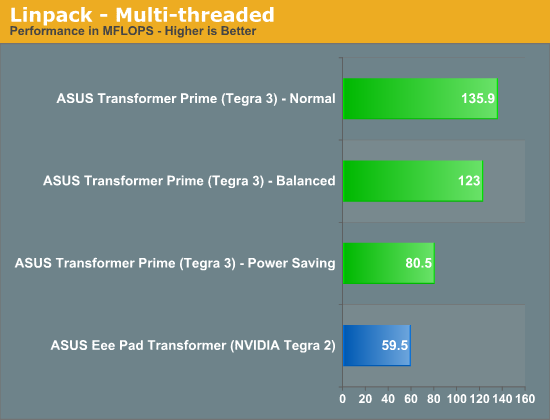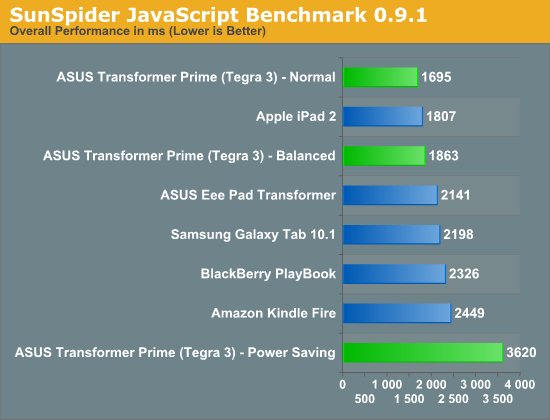ASUS Eee Pad Transformer Prime & NVIDIA Tegra 3 Review
by Anand Lal Shimpi on December 1, 2011 1:00 AM ESTCPU Performance
The big news with Tegra 3 is that you get four ARM Cortex A9 cores with NEON support instead of just two (sans NEON) in the case of the Tegra 2 or most other smartphone class SoCs. In the short period of time I had to test the tablet I couldn't draw many definitive conclusions but I did come away with some observations.
Linpack showed us healthy gains over Tegra 2 thanks to full NEON support in Tegra 3:


As expected, finding applications and usage models to task all four cores is pretty difficult. That being said, it's not hard to use the tablet in such a way that you do stress more than two cores. You won't see 100% CPU utilization across all four cores, but there will be a tangible benefit to having more than two. Whether or not the benefit is worth the cost in die area is irrelevant, it only means that NVIDIA (and/or its partners) have to pay more as the price of the end product to you is already pretty much capped.


The bigger benefit I saw to having four cores vs. two is that you're pretty much never CPU limited in anything you do when multitasking. Per core performance can always go up but I found myself bound either by the broken WiFi or NAND speed. In fact, the only thing that would bring the Prime to a halt was if I happened to be doing a lot of writing to NAND over USB. Keyboard and touch interrupts were a low priority at that point, something I hope to see addressed as we are finally entering the era of performance good enough to bring on some I/O crushing multitasking workloads.

Despite having many cores at its disposal, NVIDIA appears to have erred on the side of caution when it comes to power consumption. While I often saw the third and fourth cores fire up when browsing the web or just using the tablet, NVIDIA did a good job of powering them down when their help wasn't needed. Furthermore, NVIDIA also seems to prefer running more cores at lower voltage/frequency settings than fewer cores at a higher point in the v/f curve. This makes sense given the non-linear relationship between voltage and power.
From a die area perspective I'm not entirely sure having four (technically, five) A9 cores is the best way to deliver high performance, but without a new microprocessor architecture it's surely more efficient than just ratcheting up clock speed. I plan on providing a more thorough look at Tegra 3 SoC performance as I spend more time with a fixed Prime, but my initial impressions are that the CPU performance isn't really holding the platform back.










204 Comments
View All Comments
Mumrik - Thursday, December 1, 2011 - link
I get the feeling Anand didn't enjoy the 39 hour thing :)Btw:
"The resolution is a Honeycomb-standard 1280 x 752. The 16:10 panel measures 10.1-inches diagonally,"
Huh? 1280x752?
That's not a 16:10 resolution...
Anand Lal Shimpi - Thursday, December 1, 2011 - link
It's technically 1280 x 800, the 752 is what you get when you remove the Honeycomb nav bar.mwildtech - Thursday, December 1, 2011 - link
Great Review Anand! Much better than Engadget's. We are lucky we still got nice sunny skies in Raleigh!SpacemanSpiff13 - Thursday, December 1, 2011 - link
Awesome review, Anand. I already had one preordered, but your review makes me really comfortable about my impulse buy, and it's not just a play for page clicks. Really solid, in-depth. Thanks.jwcalla - Thursday, December 1, 2011 - link
very well done reviewjjj - Thursday, December 1, 2011 - link
Nice to see a decent tablet and glad they didn't dropped (like some nutjobs) the microSD slot.Asus should really sell the keyboard much cheaper would help them gain considerable market share and maybe make one without the battery for 50-70$.And ofc bundle realVNC or Logmein with it.
TrackSmart - Thursday, December 1, 2011 - link
I agree that a cheaper keyboard option (or bundle w/ keyboard) would help sales.Regarding a version without the battery: the thing is already dangerously top-heavy when plugged into the dock. Can you imagine how bad it would be without the weight of the battery in there? They'd probably have to put some kind of weight near the front edge. Or use a design that connects the tablet further inward on the dock, as has been done on other tablets, which would ruin the laptop-like aesthetic (which is pretty nice).
Just my 2 cents.
jjj - Friday, December 2, 2011 - link
I was aware of that problem and amusingly enough i was also thinking about the same 2 solutions..The version without battery would be just to bring the price down a lot.The battery costs 20-25$ and that adds 40-70$ to the retail price so it would make a big difference.joe_dude - Thursday, December 1, 2011 - link
Personally, I'm not so interested in comparisons to the iPad. What I really want to know is how it compares to a tablet + netbook/ultrabook/MBA???If it can do a decent job in both roles, then it would really make life easier. Wouldn't need to sync files or deal with two different OSes. Save time and money.
Anand Lal Shimpi - Thursday, December 1, 2011 - link
Better than a netbook (what isn't? :-P) but not as good as an ultrabook/MBA for getting actual work done.Take care,
Anand